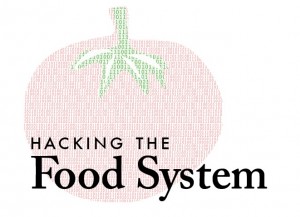[Hacking the Food System is an online conversation exploring how technology, information and data can change the food system status quo. Join the conversation below, on Twitter (hashtag #foodtech), or Facebook.]
 According to the U.S. Department of Labor, the average family spends nearly $4000 a year on groceries. The majority of us still make regular trips to the supermarket to stock up on everything from dairy products to frozen foods. We currently navigate over 50,000 products at the average supermarket. Segments like low-fat and diet products continue to grow while newer categories like gluten-free, organic and even vegan further complicate our choices. Stores like Trader Joe’s and Whole Foods brought about an entirely new selection of unfamiliar products and brands both large and small.
According to the U.S. Department of Labor, the average family spends nearly $4000 a year on groceries. The majority of us still make regular trips to the supermarket to stock up on everything from dairy products to frozen foods. We currently navigate over 50,000 products at the average supermarket. Segments like low-fat and diet products continue to grow while newer categories like gluten-free, organic and even vegan further complicate our choices. Stores like Trader Joe’s and Whole Foods brought about an entirely new selection of unfamiliar products and brands both large and small.
Ultimately the decision you make in the aisle has turned into a game of trial and error. You know those food brands or products you avoid at the supermarket? Of course you do. You paid for them, brought them home and found out they were terrible. Try returning your half-eaten food to the supermarket and say “this didn’t taste good.”
The digitization of food has ensured a critical mass of content surrounding many, but not all of the food choices we make. Web and mobile restaurant platforms provide recommendations down to the dish. When it comes to recipes you can take your pick from behemoths to emerging startups. Even with the perfect instructions how do you know which canned tomato is the best to make that sauce recipe?
While we can read about the nutrition and make common sense decisions about ingredients thanks to package labeling, there’s no way to tell the quality of the product by looking at the package. The nondescript store brand might be the best one out there and that famous chef’s face might have been slapped on a disappointing product. There’s no easy way to know what’s the best or worst and you certainly can’t try before you buy, except maybe for grapes.
What if the combination of technology and information could allow you to virtually sample grocery products via the experiences of others, just like you do for restaurants and recipes? What if your opinions of products were automatically combined with people in your social graph (friends) and maybe a few people who have tried everything out there?
The technology platforms and repositories to do this exist today. They only need the product experiences stored inside you and your friends. We should all seek out the platforms that have the goal of helping consumers by contributing our knowledge and experiences. This digital revolution starts on the web, but in the near future this information will go mobile. The power to make individual food product decisions will be in the palm of your hand. The recipe calls for Greek yogurt? Here are your best options. Oh you need 0% fat? How about these instead? Try the gray stuff, it’s delicious! Don’t believe me? Ask the dishes!
I have a vision for the future where technology has hacked the grocery system to the point where there’s only one aisle. We won’t need 50,000 options. Product choices would be consolidated to only the best or most unique options. You’ll stroll down that aisle in a carefree fashion knowing that you can never go wrong. And the answer to “where can I find…” is always aisle 1.
___________________
Ryan Charles is the founder of Consmr, a user review website for supermarket products. He is an advocate of consumers making smart food choices that make them happy. Prior to founding Consmr, Ryan was Head of Mobile for Zagat where he was responsible for their best-selling apps as well as forward-thinking integrations with companies like Foodspotting, Foursquare and Flipboard. You can follow him on Twitter or read more on his blog at ryenyc.tumblr.com.
Related articles
- Joanne Wilson on Hacking the Food System (foodandtechconnect.com)
- Ali Partovi on Hacking the Food System: Focus on the Supply Chain (foodandtechconnect.com)
- Marcus Samuelsson on Hacking the Food System: Taking Food to a Whole New Level (foodandtechconnect.com)
- Hilary Mason on Hacking the Food System: The Story of the Ultimate Cookie (foodandtechconnect.com)
- Bill Niman on Hacking the Food System (foodandtechconnect.com)
- Jeff Miller on Hacking the Food System: The Final Link (foodandtechconnect.com)
- Stefani Bardin on Hacking the Food System (foodandtechconnect.com)
- Dickson Despommier on Hacking the Food System (foodandtechconnect.com)




